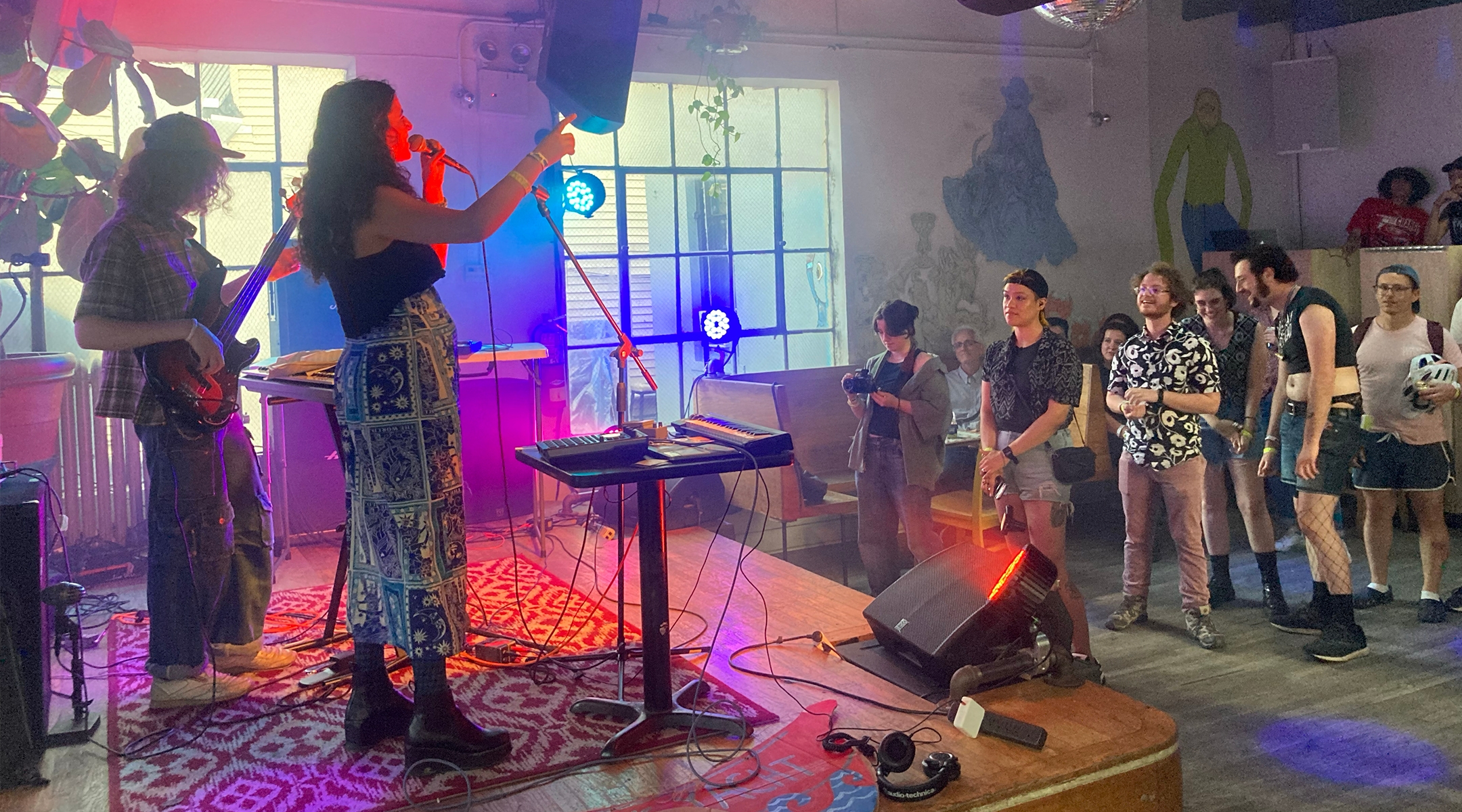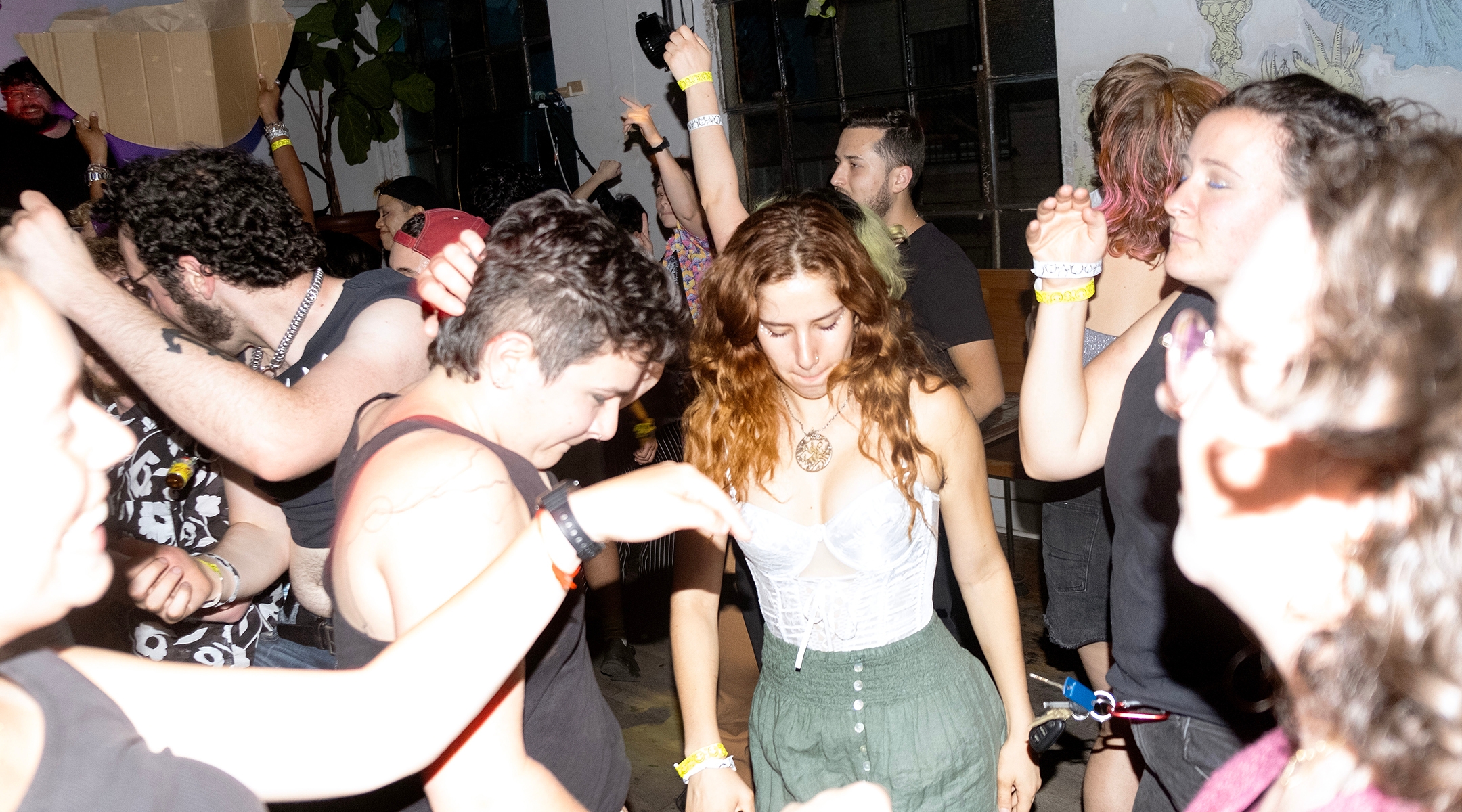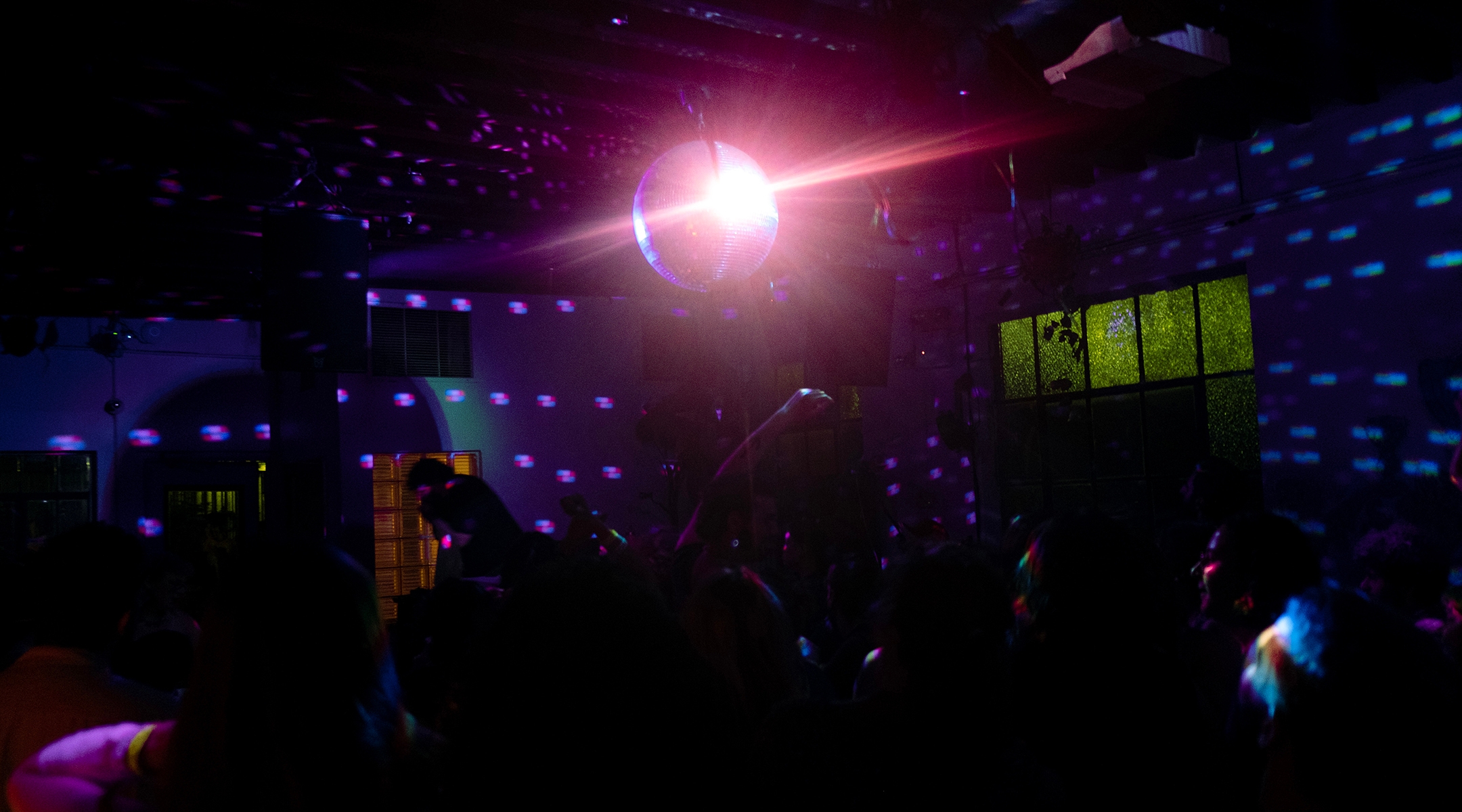(New York Jewish Week) — On a recent Thursday in Ridgewood, the Queens neighborhood that straddles the border of uber-hip Bushwick, Brooklyn, a crowd of music fans filled the room at Trans-Pecos, an all-ages music and events venue.
It’s a scene that’s pretty familiar to anyone who’s been to an outer-borough club in recent years: A homey, DIY kind of space with creaky wood floors and plants as decoration; a limited menu of pricey drinks; a young, casual and queer-leaning crowd, albeit with a smattering of “elders” along the sidelines.
But on this particular July evening, the event was celebrating the unique intersection of klezmer music and rave culture. The room was packed with Jewish ravers, for the third New York installment of “Kleztronica,” a burgeoning Jewish music scene that’s becoming a “movement,” according to its 22-year-old creator, Upper West Side native Kaia Berman-Peters.
A singer and a musician, Berman-Peters performs original Jewish songs over the electronic beats of house music and snippets of klezmer, resulting in something akin to Yiddish hip-hop or Jewish techno. With these mashups, she’s building upon a decades-old crossover tradition pioneered in the 1990s and early 2000s by rapper-producer Josh Dolgin, aka Socalled, who created hip-hop songs from samples of Jewish records.
Berman-Peters, who also goes by Chaia, is aiming for something bigger than a danceable tune or a fun night out. “I see Kleztronica as a movement,” she told the New York Jewish Week ahead of the show. “It represents a certain type of diasporism; of recentering Judaism in the Diaspora. I do see it as a movement, a community, but primarily a set of ideas and ways of practicing those ideas.”
The first of these ideas, she said, is a deeply rooted respect for Yiddish tradition and Jewish ancestry. The second honors “the Black and radical lineage of electronic music: Chicago house music, dub in Jamaica, house in Detroit.”
The third is a commitment to “rave space as safe space,” she said, referring to a welcoming, queer-friendly, non-judgmental environment. And the fourth, she said, is Diaspora, specifically “Diaspora without a desire to return” — reflecting the function that Yiddish can play for Jews who do not want to root their identity or engagement in Israel.
“These little raves are just one part of living an exuberant Jewish life centered in the Diaspora,” Berman-Peters said, “centered in learning and in ancestral respect.”

UWS native Kaia Berman-Peters, the founder of Kleztronica, performs a set at Trans-Pecos on July 20, 2023. (Julian Voloj)
At the Trans-Pecos event last month, the scene was a respectful, haimish one that Berman-Peters lovingly described as “super weird” and “so cool.” The enthusiastic, intimate crowd — some wearing kippahs, others crop tops — seemed up for anything, including Slavic squat dancing, which happened later in the evening.
Berman-Peters — who also sings with with Boston-based klezmer group Mama Liga, and is a vocalist and accordionist for the klezmer-folk trio Levyosn — played a set of original songs over Jewish-inflected electronic beats. Sam Slate and Abbie Goldberg, who as drag performers Diva Nigun and Chava GoodTime, had the crowd roaring during a musical skit that had the former dressed as the captain of a cardboard ship and the latter as a shark. (“There are some things I just don’t understand,” a puzzled, more senior onlooker quipped to me.)
A highlight was a set from Éléonore Weill, a France-born Brooklyn musician who plays a hand-cranked string instrument called the hurdy-gurdy. “It’s very raw and intense,” Weill recently told the Forward about her instrument, which was wired for the Kleztronica performance. “It’s like a stringed bagpipe. A lot of people can’t handle it.”
Berman-Peters had organized the evening in partnership with Clear the Floor, a rave collective from Boston that centers Black and Indigenous people and other people of color. “The idea is that electronic dance music and techno and house is Black music,” she said of the collaboration. “And it’s music that was created by people of color and continues to be traditional music of people of color. And that we’re part of that lineage standing in solidarity with them.”
Unfortunately, a series of travel snafus meant that only one Clear the Floor rep made it to Ridgewood that evening. It didn’t seem to matter: Most of the tight-knit crowd were entwined in New York’s klezmer scene and were there to see Berman-Peters and company. The audience included klezmer luminaries like Lorin Sklamberg and Frank London — who, as founders of the Klezmatics, kicked off the klezmer revival in the 1980s — as well as representatives of the next generation, like clarinetist Michael Winograd and his Yiddish Princess cofounder, vocalist Sarah Gordon.

Performers at the Kleztronica event included a P1no, left, a DJ from Clear the Floor, a Boston-based BIPOC rave collective, and a drag performance from Diva Nigun. (Jess O’Donoghue)
But don’t mistake Kleztronica as Yiddish Revival 3.0. “I wouldn’t go so far as to say this is what klezmer is becoming, or that this is the new mainstream of klezmer, because of the diversity of genre expression within the scene,” said Aaron Bendich, the founder of Jewish music label Borscht Beat. “I think it would be misconstruing what’s going on there.”
Bendich, who has attended every New York Kleztronica event thus far, noted that past Kleztronica performers included more traditional klezmer musicians who have used their sets to experiment with new forms.
“Kaia is definitely of the new generation of klezmer performers, there’s no doubt in my mind about that,” said Bendich, who released Levyosn’s album in May. “But Kleztronica is its own thing. I don’t think it’s the son of what Michael Winograd is doing, or the grandchild of the Klezmatics.”
“It’s really exciting,” said musician Slate about this new shoot on the klezmer family tree, who was cooling off in Trans-Pecos’ expansive backyard ahead of his set. (Slate uses he/they pronouns in day-to-day life and she/her as Diva Nigun.) “There’s such a cultural shift among young Jews to explore, to reinvigorate, for Ashkenazi Jews, Yiddish culture and yiddishkeit.”
Slate and Berman-Peters met about a year ago at an anarchist havdalah in Prospect Park, which is possibly the most Brooklyn sentence I have ever written. Incredibly, it turned out that they both lived in Boston and made electronic Jewish music but had never crossed paths before.
Since then, Slate has collaborated with Berman-Peters on Kleztronica events in both cities. “It was only a matter of time because the music is so rich, and has so much to offer,” Slate said. “I grew up secular but it’s so deep in my bones still.”
“We wanted to make electronic music that wasn’t just kitschy — it wasn’t just a joke or a punchline,” he said of Kleztronica’s evolution. “There are very few artists who have been able to balance that, and it felt really exciting that there were a bunch of us [doing this] at the same time.”

Revelers get down to the sounds of Kleztronica at Trans-Pecos on July 20, 2023. (Jessica O’Donoghue)
Berman-Peters grew up in an academic, Jewish and musical home in Manhattan. Her mother, Julie Stone Peters, is a professor of literature and theater at Columbia University; her father, Nathaniel Berman, is a professor at Brown University specializing in Kabbalah and Jewish mysticism. Not only did she “grow up on campus” at Columbia, “I grew up sort of with a stream of rabbis, cantors and Jewish musicians sort of coming in and out of our house to hear my dad teach,” she said. “And that was really cool.”
One of her father’s students was Basya Schecter, founder of the Jewish world music/folk band Pharaoh’s Daughter, who became a close family friend and “a mentor to me, musically,” Berman-Peters said. Her interest in klezmer began in high school when she took up the accordion and joined the Columbia Klezmer Ensemble — which was open to anyone, not just Columbia students — led by renowned klezmer musician, cantor and educator Jeff Warschauer.
At Warschauer’s urging, as she was set to graduate from the Heschel School, Berman-Peters applied to the New England Conservatory of Music, which is nicknamed the “Klezmer Conservatory” because it is home to the Klezmer Conservatory Band, led by Hankus Netsky.
“I didn’t have that rigorous of a musical background; I didn’t really think I could get in,” she said. But “get in” she did, and Berman-Peters began a joint bachelor’s and master’s degree program in partnership with Harvard University in 2019.
In college, while studying accordion and klezmer music, Berman-Peters began to get serious about DJing and electronic music. “I started feeling really inspired by a lot of different artists who make electronic music that expresses their cultural roots,” she said, pointing to artists like Sofia Kourtesis, whose music draws upon Peruvian culture and protest tradition. “And I thought I could do that, too.”
At the moment, Berman-Peters is taking time off from completing her degree to pursue Kleztronica full-time. She just completed recording her first Kleztronica album and the next Kleztronica events in New York are slated for October and December.
Currently living with her parents on the Upper West Side, she expresses wonder at how rapidly her burgeoning vision is catching on, considering that the first-ever Kleztronica event happened just this past December, when she proposed the idea to Pete Rushefsky, a founder of the Yiddish New York festival, who was enthusiastically all-in.
“I expected it to just be people from the klezmer scene that I knew, and maybe people interested in music, but it’s all people from all walks of Jewish life that I totally didn’t expect,” she said of her fans, pointing specifically to Jewish hippies and ex-haredi party people.
She said that while attendees have mostly been Jews so far, she doesn’t think the audience ends there.
“I hope that more non-Jews start coming because I really think being culturally rooted and making dance music is what dance music was all about in the first place,” she said. “So I really hope that more people who are not Jewish come to this, and see our version of it, and our version of what Judaism looks like, too.”
The New York Jewish Week brings you the stories behind the headlines, keeping you connected to Jewish life in New York. Help sustain the reporting you trust by donating today.





